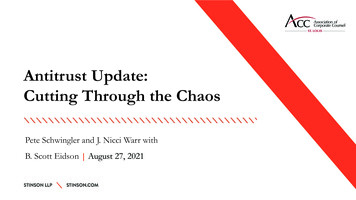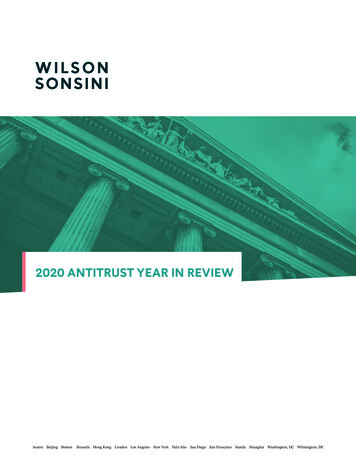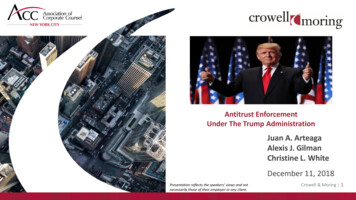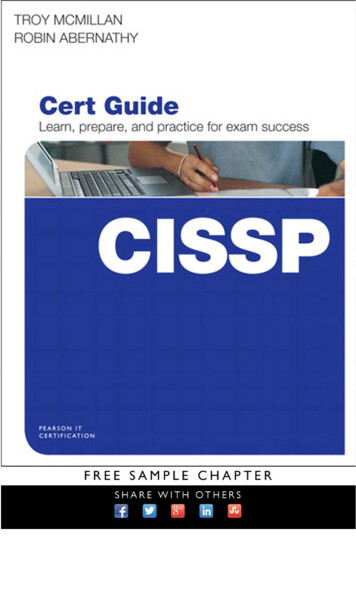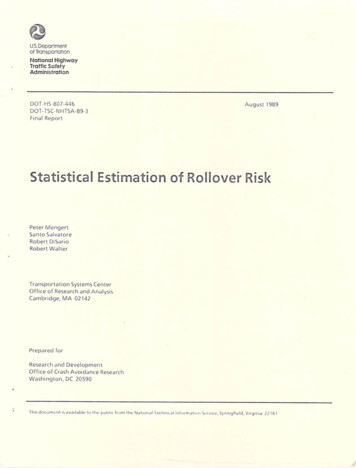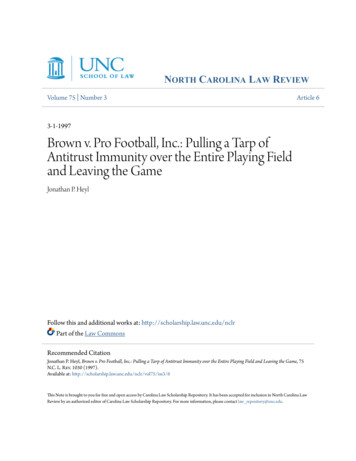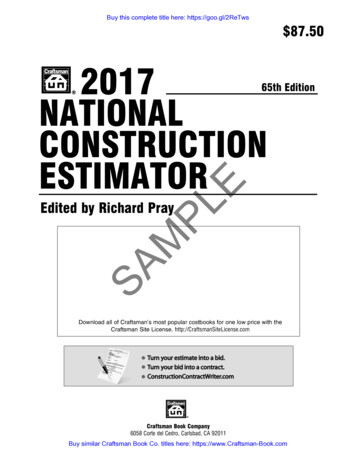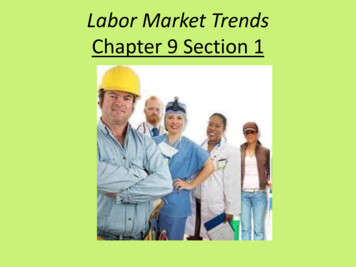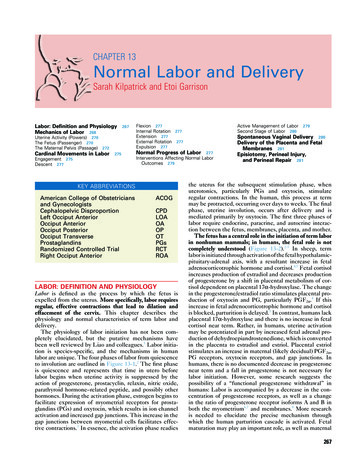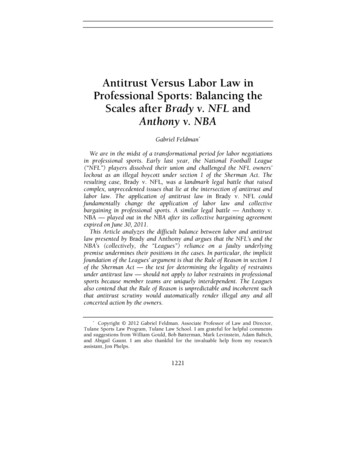
Transcription
Antitrust Versus Labor Law inProfessional Sports: Balancing theScales after Brady v. NFL andAnthony v. NBAGabriel Feldman*We are in the midst of a transformational period for labor negotiationsin professional sports. Early last year, the National Football League(“NFL”) players dissolved their union and challenged the NFL owners’lockout as an illegal boycott under section 1 of the Sherman Act. Theresulting case, Brady v. NFL, was a landmark legal battle that raisedcomplex, unprecedented issues that lie at the intersection of antitrust andlabor law. The application of antitrust law in Brady v. NFL couldfundamentally change the application of labor law and collectivebargaining in professional sports. A similar legal battle — Anthony v.NBA — played out in the NBA after its collective bargaining agreementexpired on June 30, 2011.This Article analyzes the difficult balance between labor and antitrustlaw presented by Brady and Anthony and argues that the NFL’s and theNBA’s (collectively, the “Leagues”) reliance on a faulty underlyingpremise undermines their positions in the cases. In particular, the implicitfoundation of the Leagues’ argument is that the Rule of Reason in section 1of the Sherman Act — the test for determining the legality of restraintsunder antitrust law — should not apply to labor restraints in professionalsports because member teams are uniquely interdependent. The Leaguesalso contend that the Rule of Reason is unpredictable and incoherent suchthat antitrust scrutiny would automatically render illegal any and allconcerted action by the owners.*Copyright 2012 Gabriel Feldman. Associate Professor of Law and Director,Tulane Sports Law Program, Tulane Law School. I am grateful for helpful commentsand suggestions from William Gould, Bob Batterman, Mark Levinstein, Adam Babich,and Abigail Gaunt. I am also thankful for the invaluable help from my researchassistant, Jon Phelps.1221
1222University of California, Davis[Vol. 45:1221The Leagues’ attacks on the Rule of Reason disregard the balancebetween antitrust and labor law, and represent yet another misguidedattempt to achieve the “Shangri-la of everlasting immunity from theantitrust laws.” The assault on the Rule of Reason and antitrust law ismisplaced for three reasons. First, courts consistently have held that theRule of Reason applies to professional sports leagues, despite theinterdependence of their member teams. Second, reasonable ownerimposed player restraints can, and have, survived antitrust scrutiny underthe Rule of Reason. Third, although the Rule of Reason is an imperfectmethod for determining the legality of restraints, these imperfections donot justify elevating labor law over antitrust law after the dissolution of aplayers’ unions. The imperfections in the Rule of Reason test can beeliminated, or at least minimized, through the formulation of a morecoherent, predictable, and workable Rule of Reason. This Article proposesa new model for streamlining the Rule of Reason test that will aid courtsin applying the doctrine and allow for a more appropriate balancebetween federal antitrust and labor policy.TABLE OF CONTENTSINTRODUCTION . 1223I. THE ORIGIN AND EVOLUTION OF THE LABOR EXEMPTIONS TOANTITRUST LAW . 1227II. THE EVOLUTION OF THE NONSTATUTORY LABOR EXEMPTIONIN PROFESSIONAL SPORTS . 1232A. Multi-Employer Bargaining and Antitrust Scrutiny . 1232B. The Unique Nature of Sports Unions . 1236C. The Evolution of the Nonstatutory Labor Exemption inProfessional Sports . 1238D. The Latest Stage in the Evolution of the NonstatutoryLabor Exemption: Brady v. NFL and. Anthony v. NBA . 12491. Brady v. NFL . 12492. Anthony v. NBA . 1251III. THE NONSTATUTORY LABOR EXEMPTION MUST TERMINATEAFTER THE DISSOLUTION OF A UNION . 1252A. Extending the Nonstatutory Labor Exemption to CoverPost-Dissolution Agreements Would Subvert Both FederalLabor and Antitrust Policy . 1253B. No Conflict Exists between Antitrust and Labor Law Afterthe Dissolution of a Union . 1259C. The Leagues Are Attempting to Manipulate theNonstatutory Labor Exemption to Gain Broad Immunityfrom Antitrust Law . 1266
2012]Antitrust Versus Labor Law in Professional Sports1223IV. EVOLUTION AND CONFUSION OF THE RULE OF REASON AND APROPOSAL FOR A MORE WORKABLE APPROACH . 1278A. The Supreme Court’s Formulation of the Rule of Reasonand Its Short Comings . 1279B. The Addition of the Less Restrictive Alternative as anIndependent Prong of the Rule of Reason . 1281C. Towards a New Rule of Reason Standard . 12891. Market Power Filter as a Heuristic . 12892. Use of the Less Restrictive Alternative Inquiry toHelp Determine Competitive Effects . 12913. Seeking Guidance from Proportionality Analysis . 1295CONCLUSION. 1300INTRODUCTIONEarlier last year, the National Football League (“NFL”) playersdissolved their union in order to challenge the NFL owners’ lockout asan illegal boycott under section 1 of the Sherman Act. The case, Bradyv. NFL,1 was a landmark legal battle that raised complex,unprecedented issues that intersect antitrust and labor law in a waythat could fundamentally alter collective bargaining in professionalsports. A similar legal battle — Anthony v. NBA2 — ensued in the NBAafter its collective bargaining agreement with its players expired onJune 30, 2011.Brady and Anthony represent a core disagreement regarding the roleof antitrust and labor law in professional sports. The two areas of lawinherently conflict.3 Antitrust law — in particular, section 1 of theSherman Act4 — encourages competition and prohibits cooperationamong competitors. Labor law, by contrast, encourages cooperationamong employees (i.e., competitors for employment) and betweenemployers and employees.5 To reconcile this conflict and to promotecollective bargaining, Congress and the courts have immunized the1644 F.3d 661, 663 (8th Cir. 2011).Complaint, Anthony v. NBA, No. 11-5525 (N.D.Cal. Nov. 15, 2011).3See, e.g., Douglas L. Leslie, Principles of Labor Antitrust, 66 VA. L. REV. 1183,1184 (1980) (“[T]he antitrust statutes promote competition and economic efficiency,while the federal labor statutes sanction activity that is arguably anticompetitive.”).4Section 1 of the Sherman Act, 15 U.S.C. § 1 (2006), provides in relevant part:“Every contract, combination in the form of trust or otherwise, or conspiracy, inrestraint of trade or commerce among the several States, or with foreign nations, isdeclared to be illegal.”5See Local Union No. 189, Amalgamated Meat Cutters & Butcher Workmen ofN. Am. v. Jewel Tea Co., Inc., 381 U.S. 676, 711 (1965).2
1224University of California, Davis[Vol. 45:1221collective bargaining process and resulting agreements from antitrustclaims through a doctrine known as the “nonstatutory laborexemption.”6 Absent this immunity, many of the terms contained incollective bargaining agreements in professional sports — includingsalary caps, player drafts, and restrictions on free agency — would besubject to antitrust scrutiny.7Courts have extended this immunity beyond the expiration of acollective bargaining agreement. The Supreme Court held in Brown v.Pro Football, Inc.8 that the NFL owners’ unilateral post-impasse9imposition of employment terms was protected from antitrust attack.In Brown, the NFL players and owners negotiated to an impasseregarding the salary for “developmental squad” players.10 The owners,as permitted under labor law, then unilaterally implemented their last,best offer — a fixed salary scale for all players on the developmentalsquad.11 Although this fixed salary was not part of a collectivebargaining agreement, the Supreme Court held that the nonstatutorylabor exemption doctrine immunized the owners’ offer from antitrustclaims.12 The Court reasoned that a collective bargaining relationshipexisted between the owners and the players, and that the applicationof antitrust law would interfere with federal labor policy and thecollective bargaining process.13Brady and Anthony raised the question of whether the ruleannounced in Brown shields a lockout or other concerted ownerconduct from antitrust attack, even after the players have dissolvedtheir union. The NFL and NBA (the “Leagues”) portray these cases as6A statutory labor exemption is contained in the Clayton Act, 15 U.S.C. § 17(2006), and the Norris-LaGuardia Act, 29 U.S.C. §§ 52, 105 (2006). The“nonstatutory labor exemption” is a judicially created addition to the statutoryexemption. Connell Constr. Co. v. Plumbers & Steamfitters Local Union No. 100, 421U.S. 616, 621-22 (1975).7See, e.g., Mackey v. NFL, 543 F.2d 606, 620-22 (8th Cir. 1976) (applying theRule of Reason to restrictions on player movement in the NFL); Smith v. Pro-FootballInc., 420 F. Supp. 738, 746-47 (D.D.C. 1976) (applying the Rule of Reason to thecollege player draft).8518 U.S. 231, 250 (1996).9An “impasse” in negotiations occurs when “good faith negotiations haveexhausted the prospects of concluding an agreement, leading both parties to believethat they are at the end of their rope.” NLRB v. Whitesell Corp., 638 F.3d 883, 890(8th Cir. 2011) (citing TruServ Corp. v. NLRB., 254 F.3d 1105, 1114 (D.D.C. 2001)(citations and footnotes omitted)).10Brown, 518 U.S. at 235.11Id.12Id. at 250.13Id.
2012]Antitrust Versus Labor Law in Professional Sports1225labor disputes and argue that concerted league conduct subsequent toa players’ union dissolution should be exempt from antitrust scrutiny.The Leagues’ argument is twofold. First, the Leagues contend that theyhave a statutorily protected right to implement a lockout to puteconomic pressure on the players.14 Second, the Leagues argue thatthrusting antitrust law into these disputes would destroy multiemployer bargaining and interfere with the labor process.15This Article argues that immunizing concerted owner conduct (suchas a lockout) from antitrust attack after the dissolution of a union isinconsistent with Brown and the rationale underlying the nonstatutorylabor exemption. A basic tenet of labor law holds that employees havea right to choose not to be represented by a union and to refrain fromcollective bargaining.16 If employees choose to forego collectivebargaining and opt to negotiate and compete for employmentopportunities individually, antitrust — and not labor law — applies.17Depriving employees of their right to sue under section 1 of theSherman Act on the grounds that they chose not to engage incollective bargaining would frustrate both antitrust and labor policy.This Article also argues that the Leagues’ view of the appropriatebalance between antitrust and labor law rests on a faulty premise. Inparticular, the implicit foundation of the Leagues’ argument is that theRule of Reason in section 1 of the Sherman Act — the test fordetermining the legality of restraints under antitrust law — should notapply to labor restraints in professional sports because teams areuniquely interdependent. The Leagues also contend that the Rule ofReason is unpredictable and incoherent, and that antitrust scrutinywould automatically render illegal any and all concerted owner action.Courts have consistently rejected these arguments over the pastseveral decades.18The Leagues’ expansive interpretation of the nonstatutory laborexemption in Brady and NPA is little more than a repackaging of thesearguments. Once again, the Leagues’ arguments represent yet anothermisguided attempt at achieving the “Shangri-la of everlastingimmunity from the antitrust laws.”19 That interpretation disregards the14See Brady v. NFL, 644 F.3d 661, 673 (8th Cir. 2011); Complaint at 17-20, NBAv. NBPA, No. 11 Civ. 5369 (S.D.N.Y. Aug. 2, 2011).15See Brady, 644 F.3d at 667; Complaint, supra, note 14 at 17-20.1629 U.S.C. § 157 (2006).17See Brown v. Pro Football, Inc., 50 F.3d 1041, 1057 (D.C. Cir. 1995); see infraPart IV.18See, e.g., American Needle v. NFL, 130 S. Ct. 2201, 2216-17 (2010).19Powell v. NFL, 930 F.2d 1293, 1309 (8th Cir. 1989) (Lay, C.J., dissenting).
1226University of California, Davis[Vol. 45:1221balance between antitrust and labor law, and is misplaced for threereasons. First, courts consistently have held that the Rule of Reasonapplies to professional sports leagues, despite the interdependence oftheir member teams.20 Second, reasonable owner-imposed playerrestraints can, and have, survived antitrust scrutiny under the Rule ofReason in past cases.21 Third, although the Rule of Reason is animperfect method for determining the legality of restraints on trade,22these imperfections do not justify elevating labor law over antitrustlaw after the dissolution of a union. The imperfections in the Rule ofReason can be eliminated, or at least minimized, through theformulation of a more coherent, predictable, and workable test. ThisArticle proposes a model for streamlining and improving Rule ofReason. The proposed model will aid courts in applying the Rule ofReason and allow for a more appropriate balance between federalantitrust and labor policy.This Article proceeds as follows: Part I provides an overview of theconflict between antitrust and labor law, and examines the statutoryand judicial exemptions created to reconcile the inherent tensionbetween these areas of law. Part II explores the unique aspects ofcollective bargaining in professional sports and analyzes the evolutionof the nonstatutory labor exemption through sports antitrust cases.Part III discusses the issues raised in Brady and Anthony, and analyzesthe Leagues’ argument that the nonstatutory labor exemption shieldsteam owners from antitrust scrutiny after the players have dissolvedtheir union. Part IV explains that the Leagues’ interpretation of theexemption frustrates both antitrust and labor policy. Moreover, theLeagues’ interpretation relies on the faulty premise that the Rule ofReason in section 1 should not apply to labor restraints in professionalsports. This Part also explores other contexts in which sports leagueshave unsuccessfully argued that their conduct should be immune fromantitrust law. Part V discusses the evolution of the Rule of Reason andthe confusion surrounding the application of the test in addition toproviding a model for creating a more coherent and streamlined Ruleof Reason analysis. This Part explains that this new model will aid20See Radovich v. NFL, 352 U.S. 445, 449-52 (1957); N. Am. Soccer League v.NFL, 670 F.2d 1249, 1257 (2d. Cir. 1982); Smith v. Pro-Football, Inc., 593 F.2d 1173,1177-82 (D.C. Cir. 1978).21See, e.g., Neeld v. NHL, 594 F.2d 1297, 1298-1300 (9th Cir. 1979) (holdinglegal under the Rule of Reason a rule that barred partially blind players).22See, e.g., Richard Posner, The Next Step in the Antitrust Treatment of RestrictedDistribution: Per Se Legality, 48 U. CHI. L. REV. 6, 15 (1981) (commenting that the Ruleof Reason is “[a] standard so poorly articulated and particularized, applied bytribunals so poorly equipped to understand and apply it”).
2012]Antitrust Versus Labor Law in Professional Sports1227courts in applying the Rule of Reason and clarify the issues raisedwhen antitrust conflicts with labor law.I.THE ORIGIN AND EVOLUTION OF THE LABOR EXEMPTIONS TOANTITRUST LAWBrady and Anthony present the latest conflict between antitrust andlabor law. Both cases raise complex and novel issues that coulddramatically shift the balance between antitrust and labor law, as wellas the balance of power between players and owners in collectivebargaining. Before delving into Brady and Anthony, it is necessary tounderstand the nature of the conflict between federal antitrust andlabor policy, and how Congress and the courts have reconciled thisconflict over the last several decades.The starting point of the analysis is the recognition of the inherenttension between federal antitrust and labor law. Antitrust lawpromotes competition and condemns cooperation among competitors.Section 1 of the Sherman Act explicitly prohibits “[e]very contract . . .or conspiracy, in restraint of trade or commerce among the severalStates.”23 Federal labor law, by contrast, encourages cooperationamong competitors in employment.24 One of the fundamentalprinciples of federal labor policy is that employees may eliminatecompetition among themselves through the formation of a union toserve as their exclusive bargaining representative.25 The impact of this2315 U.S.C. § 1 (2006). Antitrust law is a powerful weapon in that it providesprivate plaintiffs with “treble” damages. See, e.g., Sean W.L. Alford, Dusting Off the AK47: An Examination of NFL Players’ Most Powerful Weapon in an Antitrust LawsuitAgainst the NFL, 88 N.C. L. REV. 212, 213 (2009) (referring to antitrust litigation as“the collective bargaining equivalent of an AK-47”).24See id. at 666.25See United Mine Workers of Am. v. Pennington, 381 U.S. 657, 666 (1965)(“This Court has recognized that a legitimate aim of any national labor organization isto obtain uniformity of labor standards and that a consequence of such union activitymay be to eliminate competition based on differences in such standards.” (citationomitted)).Section 9(a) of the National Labor Relations Act provides that “[r]epresentativesdesignated or selected . . . by the majority of the employees in a unit . . . shall be theexclusive representatives of all the employees in such unit for the purposes ofcollective bargaining.” 29 U.S.C. § 159(a) (2006). Labor law thus permits employeesto seek the best deal for the greatest number by exercising collective rather thanindividual bargaining power. Once an exclusive representative has been selected, theindividual employee is forbidden by federal law — unless specifically permitted by thecollective bargaining representative — from negotiating directly with the employerabsent the representative’s consent. See, e.g., NLRB v. Allis-Chalmers Mfg. Co., 388U.S. 175, 180 (1967) (finding that an individual employee’s bargaining rights are
1228University of California, Davis[Vol. 45:1221conflict is notable. For more than twenty years after the passage of theSherman Act, courts routinely held that unions do not illegallyrestrain trade in violation of antitrust law.26To alleviate this inherent conflict (and in response to court rulings),the Norris-LaGuardia Act27 and sections 6 and 20 of the Clayton Act28created what has become known as the “statutory labor exemption” toantitrust claims. Section 6 of the Clayton Act declares that “the laborof a human being is not a commodity or article of commerce” andprovides that the antitrust laws do not prohibit labor organizations.29The Norris–LaGuardia Act and Section 20 of the Clayton Act limit theability of federal courts to enjoin certain labor-related activities.30 TheSupreme Court has interpreted these provisions to protect unilateralunion conduct from antitrust challenge.31In United States v. Hutcheson, the Supreme Court affirmed that theNorris-LaGuardia Act immunizes labor unions from the ShermanAct.32 Hutcheson allows labor unions to assert economic pressure onemployers “[s]o long as a union acts in its self-interest and does notcombine with non-labor groups.”33 The case also ensures the right ofunionized employees to engage in concerted activity — such aspickets and boycotts — in attempts to achieve more favorable termsand condition of employment without fear of antitrust scrutiny.34Thus, the statutory exemption makes clear that “labor unions are not“extinguished” where a collective bargaining unit represents the employee’s interests).This prohibition exists even if that employee may actually receive lower compensationunder the collective agreement than he or she would have through individualnegotiations. See, e.g., J.I. Case Co. v. NLRB, 321 U.S. 332, 338 (1944) (reasoning thatthe fact that such situations do not serve as “ground for holding generally thatindividual contracts may survive or surmount collective ones”). Labor law alsopermits other concerted activity among employees, including the right to strike,boycott, and picket.26See, e.g., United States v. Hutcheson, 312 U.S. 219, 237-39 (1941) (Stone, J.,concurring) (noting the application of antitrust law to unions).2729 U.S.C. §§ 101-115 (2006).2815 U.S.C. § 17 (2006); 29 U.S.C. § 52 (2006).2915 U.S.C. § 17 (2006). See Brown v. Pro Football, Inc., 50 F.3d 1041, 1048(D.C. Cir. 1995).30See Brown, 50 F.3d at 1048.31See id. (citing H.A. Artists & Assocs., Inc. v. Actors’ Equity Ass’n, 451 U.S. 704,714-15 (1981) and Hutcheson, 312 U.S. at 232).32Hutcheson, 312 U.S. at 235-36.33Id. at 232.34See Michael C. Harper, Multiemployer Bargaining, Antitrust Law, and TeamSports: The Contingent Choice of A Broad Exemption, 38 WM. & MARY L. REV. 1663,1669-70 (1997).
2012]Antitrust Versus Labor Law in Professional Sports1229combinations or conspiracies in restraint of trade, and exempt specificunion activities . . . from the operation of the antitrust laws.”35As the labor movement matured, the emphasis of labor policyshifted from employee organization to collective bargaining and therelationship between employee and employer.36 The National LaborRelations Act (“NLRA”) and the Labor-Management Relations Act(“LMRA”)37 established collective bargaining as the regime to governthe relationship between employers and unionized employees. Laborlaws require employers and employees to negotiate in good faith withrespect to wages, hours, and other terms and conditions ofemployment.38 Congress designed the collective bargaining process toencourage the parties to reach voluntary agreement regarding theseeconomic terms.39The statutory exemption, however, did not immunize the collectivebargaining process or collective bargaining agreements themselvesfrom potential antitrust liability.40 Rather, the statutory exemptiononly protected a labor organization’s unilateral actions and not“agreements between unions and nonlabor parties.”41 Recognizing theneed for a proper accommodation between labor law (and collectivebargaining) and antitrust law (and free competition), the SupremeCourt created what is commonly known as the “nonstatutory laborexemption.”42 As the Supreme Court stated:35Connell Constr. Co. v. Plumbers & Steamfitters Local Union No. 100, 421 U.S.616, 621-22 (1975).36See John C. Weistart, Judicial Review of Labor Agreements: Lessons from theSports Industry, 44 LAW & CONTEMP. PROBS. 109, 114 (1981) (noting the shift in focusfrom unionization to collective bargaining).3729 U.S.C. §§ 141-197 (2006). The NLRA is commonly referred to as theWagner Act. The LMRA is commonly referred to as the Taft-Hartley Act.38See, e.g., NLRB v. Am. Nat. Ins. Co., 343 U.S. 395, 401-03 (1952).39Id.40See Connell, 421 U.S. at 622.41Id.42See, e.g., id. (stating that the nonstatutory labor exemption represents a “properaccommodation between the congressional policy favoring collective bargaining underthe NLRA and the congressional policy favoring free competition in business markets”(emphasis added)); see also, e.g., Harper, supra note 34, at 1673-74 (“The nonstatutoryexemption has its source in the strong labor policy favoring the association ofemployees to eliminate competition over wages and working conditions. Unionsuccess in organizing workers and standardizing wages ultimately will affect pricecompetition among employers, but the goals of federal labor law never could beachieved if this effect on business competition were held a violation of the antitrustlaws . . . . Under this view, the purpose of the nonstatutory exemption, like that of thestatutory exemption, is to accommodate the antitrust laws to a central purpose of thelabor laws, allowing workers to organize and freely take concerted action in attempts
1230University of California, Davis[Vol. 45:1221[a]s a matter of logic, it would be difficult, if not impossible, torequire groups of employers and employees to bargaintogether, but at the same time to forbid them to make amongthemselves or with each other any of the competitionrestricting agreements potentially necessary to make theprocess work or its results mutually acceptable.43The Court thus held that “some restraints on competition imposedthrough the bargaining process must be shielded from antitrustsanctions . . . to give effect to federal labor laws and policies and toallow meaningful collective bargaining to take place.”44 Put simply, thenonstatutory labor exemption acts as a limited, implied repeal of theantitrust laws so that the “statutorily authorized collective-bargainingprocess [can] work.”45 The exemption also recognizes a preference forresolving collective bargaining disputes through voluntary agreementand labor remedies rather than judicial intervention.46 Furthermore,the exemption “has its source in the strong labor policy favoring theassociation of employees to eliminate competition over wages andworking conditions.”47In the landmark case that developed the nonstatutory laborexemption, Local Union No. 189, Amalgamated Meat Cutters & ButcherWorkmen of North America v. Jewel Tea Co. (Jewel Tea), the Courtapplied the nonstatutory labor exemption to immunize terms of ato raise wages and other terms of employment to levels higher than could be achievedby individual, noncollective bargaining in a free labor market.”); Ethan Lock, TheScope of the Labor Exemption in Professional Sports, 1989 DUKE L.J. 339, 395 (1989)(“To foster collective bargaining, the courts have willingly subordinated antitrustpolicies and immunized otherwise unlawful restraints contained in bona-fide arm’slength agreements. . . . In this context, the proper accommodation of the antitrust andlabor laws requires that the labor laws control.”).43Brown v. NFL, 518 U.S. 231, 237; see also Connell, 421 U.S. at 622 (noting thatthe goals of federal labor law could not be achieved if the anticompetitive effects ofcollective bargaining were held to violate the antitrust laws); Local Union No. 189,Amalgamated Meat Cutters & Butcher Workmen of N. Am. v. Jewel Tea Co. 381 U.S.676, 711 (1965) (explaining that federal labor policy would be “virtually destroyed”by subjecting collective bargaining to antitrust scrutiny).44Brown, 518 U.S. at 237.45Id.; see, e.g., Harper, supra note 34, at 1674 (“Jewel Tea’s nonstatutoryexemption recognized that such concerted action ultimately cannot be meaningful ifcollective agreements securing higher wages and other benefits are themselves subjectto antitrust attack.”).46See Brown, 518 U.S. at 237. See also Weistart, supra note 36, at 131 (“Federallabor policy accepts that the prevailing principle should be freedom of contract: theparties can agree to whatever terms they wish, and courts will not inquire into thewisdom or reasonableness of the bargain struck.”).47Connell, 421 U.S. at 622.
2012]Antitrust Versus Labor Law in Professional Sports1231collective bargaining agreement from antitrust attack.48 In Jewel Tea,employers challenged a term in the collective bargaining agreementprohibiting meat markets from operating before 9 PM and after 6 PMunder the Sherman Act.49 In a plurality opinion, Justice Whitebalanced the interests of the union against the potential impact on theproduct’s market. The Court held the agreement exempt from theemployers’ antitrust claims because the restriction was “of immediateand direct” concern to the employees.50 The agreement, the Courtreasoned, sought to protect workers from long working hours, and notto restrain competition in the product market.51 Justice Goldberg,authoring a separate plurality opinion, concluded that the exemptionimmunizes from antitrust attack all “collective bargaining activityconcerning mandatory subjects of bargaining under the Labor Act.”52In later cases, the Court emphasized that the nonstatutory laborexemption only serves as a limited repeal of antitrust law in certaininstances. In Connell Construction Co., Inc. v. Plumbers & SteamfittersLocal No. 100,53 the Court held that the exemption does not apply toterms of a collective bargaining agreement that only restraincompetition in the product market and not competition among theemployees in the collective bargaining relationship. Specifically, theCourt held that the exemption does not apply where the challengedrestriction is a “direct restraint on the business market [and] hassubstantial anticompetitive effects, both actual and potential, thatwould not follow naturally from the elimination of competition overwages and working conditions.”54 Extending the exemption to such arestraint would “contravene[] antitrust policies to a degree notjustified by congressional labor policy, and therefore cannot claim a48Jewel Tea Co., 381 U.S. at 711. In United Mine Workers v. Pennington, acompanion case to Jewel Tea, the Court refused to grant an exemption from theantitrust laws to an agreement between union and large coal companies that was partof an effort to disadvantage smaller, competitor coal companies. United Mine Workersv. Pennington, 381 U.S. 657, 661 (1965). Twenty years earlier, in Allen Bradley Co. v.Local No. 3, Int’l Bhd. of Elec. Workers, the Court denied immunity from the ShermanAct for a term of a collective bargaining agreement that was designed to excludecompetitor manufacturers in the product market. Allen Bradley
1224 University of California, Davis [Vol. 45:1221 collective bargaining process and resulting agreements from antitrust claims through a doctrine known as the "nonstatutory labor exemption."6 Absent this immunity, many of the terms contained in collective bargaining agreements in professional sports — including
